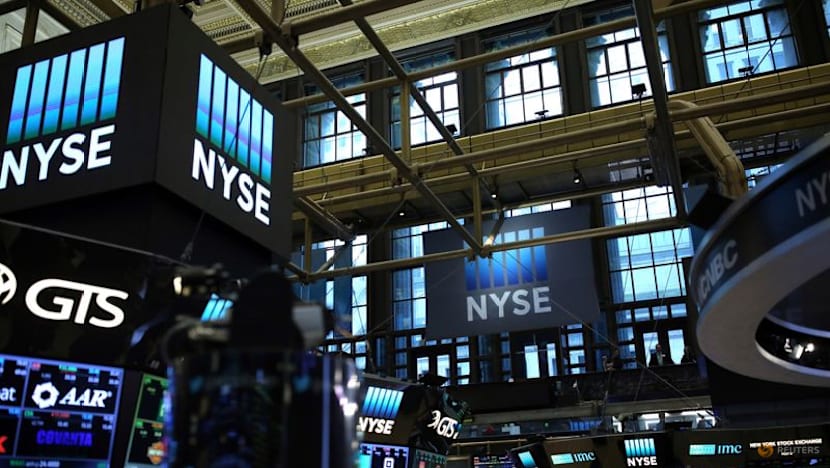Stocks fall, dollar rises as data dampens policy easing hopes

FILE PHOTO: General view of the New York Stock Exchange (NYSE) in Manhattan, New York City, U.S., December 30, 2016. REUTERS/Stephen Yang/File Photo
NEW YORK/ LONDON :MSCI's global equities gauge lost ground while the dollar rose as investors worried that Thursday's surprisingly strong U.S. economic data would make the Federal Reserve more cautious about cutting interest rates.
U.S. Treasury yields also rose after the Commerce Department's Bureau of Economic Analysis said the U.S. economy grew faster than previously thought in the second quarter, pumped up by an ebb in imports and a pickup in consumer spending. Second-quarter gross domestic product increased at an upwardly revised 3.8 per cent annualized rate versus initial reports of a 3.3 per cent pace.
Also, new orders for key U.S.-manufactured capital goods unexpectedly increased in August, but a decline in shipments of those goods suggested a moderate pace of growth in business spending on equipment this quarter.
And the Labor Department said on Thursday that the number of Americans filing new applications for unemployment benefits fell by 14,000 to a seasonally adjusted 218,000 for the week ended September 20. Economists polled by Reuters had forecast 235,000 claims for the latest week.
"If you're looking for continued fuel for equities to move higher and broaden out versus what we've seen the last couple of years, you need a continuation of the momentum that's been built over the summer in terms of the Fed easing and easing materially through 2026," said Matt Stucky, chief portfolio manager for equities at Northwestern Mutual Wealth Management Company.
Also on Thursday, Fed Bank of Chicago President Austan Goolsbee said that, while he supported last week's interest-rate cut because the labor market is cooling, he was not eager to do a lot more policy easing while inflation is above target and moving the wrong way.
But Fed Governor Stephen Miran said on Fox Business' "Mornings with Maria" program that the U.S. economy is more vulnerable to shocks right now, due to high interest rates based on unfounded inflation concerns among Federal Reserve policymakers.
San Francisco Federal Reserve Bank President Mary Daly said on Thursday that the U.S. central bank likely needs to cut interest rates further, but that it needs to move gradually as it balances risks to its twin goals of full employment and price stability.
On Wall Street, indexes marked their third straight day of losses and touched their lowest level in a week, following record high closes on Monday.
The Dow Jones Industrial Average ended down 173.96 points, or 0.38 per cent, at 45,947.32, while the S&P 500 fell 33.25 points, or 0.50 per cent, to 6,604.72 and the Nasdaq Composite lost 113.16 points, or 0.50 per cent, to finish at 22,384.70.
MSCI's gauge of stocks across the globe fell 6.15 points, or 0.63 per cent, to 973.10, marking its third straight day of losses after scoring a record closing high on Monday.
Earlier, the pan-European STOXX 600 index closed down 0.66 per cent after touching its lowest level since September 5, with med-tech stocks coming under pressure after news of the U.S. opening new import-related probes, while investors focused on Fed commentary.
In government bonds, U.S. Treasury yields rose on Thursday following stronger-than-expected second-quarter economic data that could strengthen the case for a rates pause from the Fed at its October meeting.
"It seems like we're reacting more to the GDP upside surprise," said Molly Brooks, U.S. rates strategist at TD Securities, about the uptick in two- and 10-year Treasury yields. "(But) I think markets are still biased towards seeing a slowdown in data going forward."
The yield on benchmark U.S. 10-year notes rose 2.5 basis points to 4.172 per cent, from 4.147 per cent late on Wednesday, while the 30-year bond yield fell 0.8 basis point to 4.7497 per cent.
The 2-year note yield, which typically moves in step with interest rate expectations for the Federal Reserve, rose 6.1 basis points to 3.659 per cent, from 3.598 per cent late on Wednesday.
In currencies, the dollar gained against peers including the euro and yen on signs that the U.S. economy grew faster than previous expectations in the second quarter, potentially restraining Fed rate easing.
The dollar index, which measures the greenback against a basket of currencies including the yen and the euro, rose 0.66 per cent to 98.48.
The euro was down 0.64 per cent at $1.1662, while against the Japanese yen the dollar strengthened 0.58 per cent to 149.76.
Against the Swiss franc, the dollar strengthened 0.6 per cent after the Swiss National Bank held interest rates at zero on Thursday in its first pause since late 2023.
Oil prices gave up earlier losses to settle near Wednesday's seven-week closing high as the economic data tempered optimism about the rate cut outlook.
U.S. crude settled down 0.02 per cent, or 1 cent, at $64.98 a barrel and Brent settled at $69.42 per barrel, up 0.16 per cent, or 11 cents on the day.
Safe-haven gold pulled itself back up from early session losses but was still below Wednesday's peak.
Spot gold rose 0.38 per cent to $3,749.94 an ounce. U.S. gold futures rose 0.06 per cent to $3,734.20 an ounce.
In cryptocurrencies, bitcoin was down 3.79 per cent at $109,297.18 after hitting its lowest level since early September.













